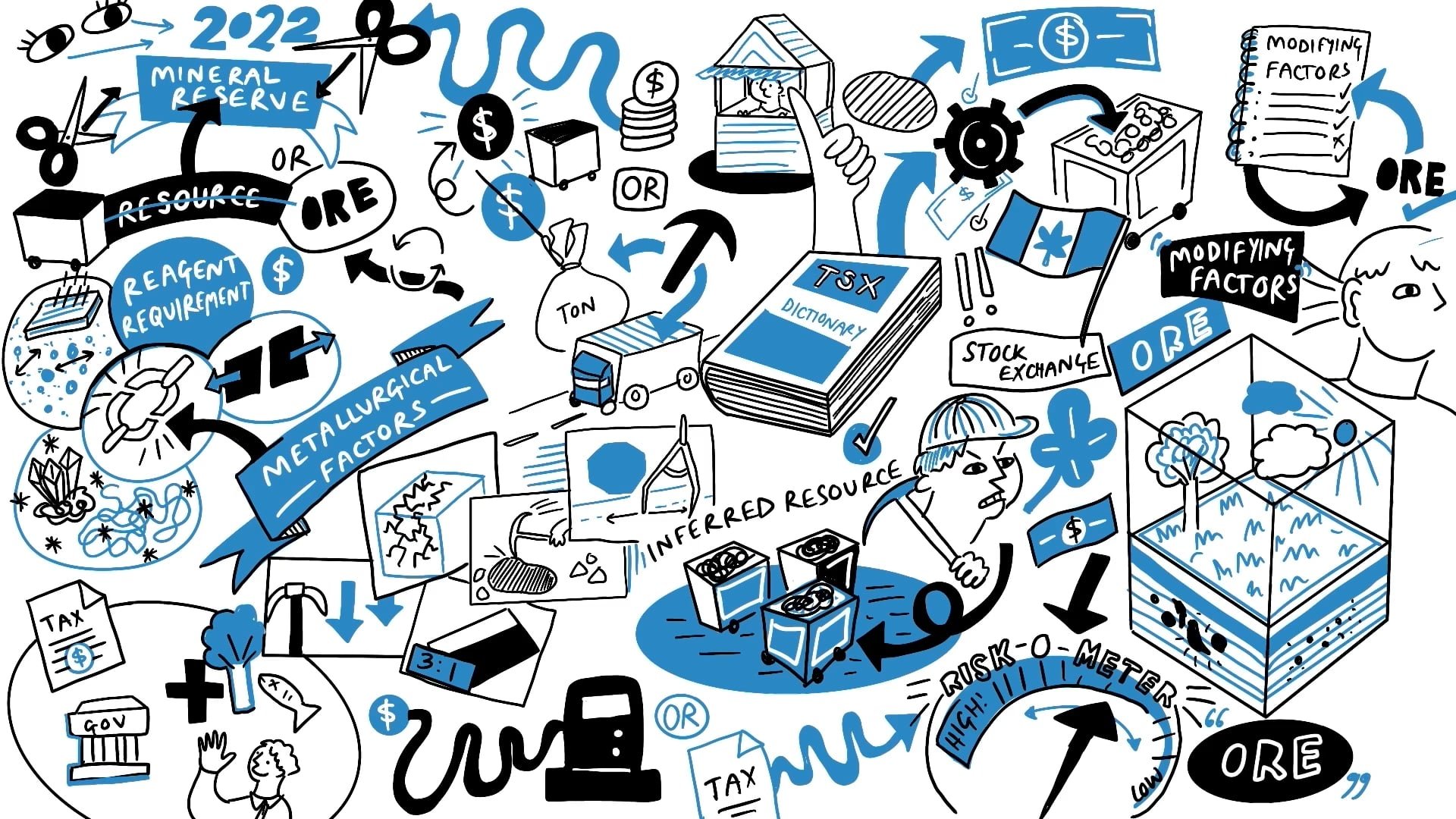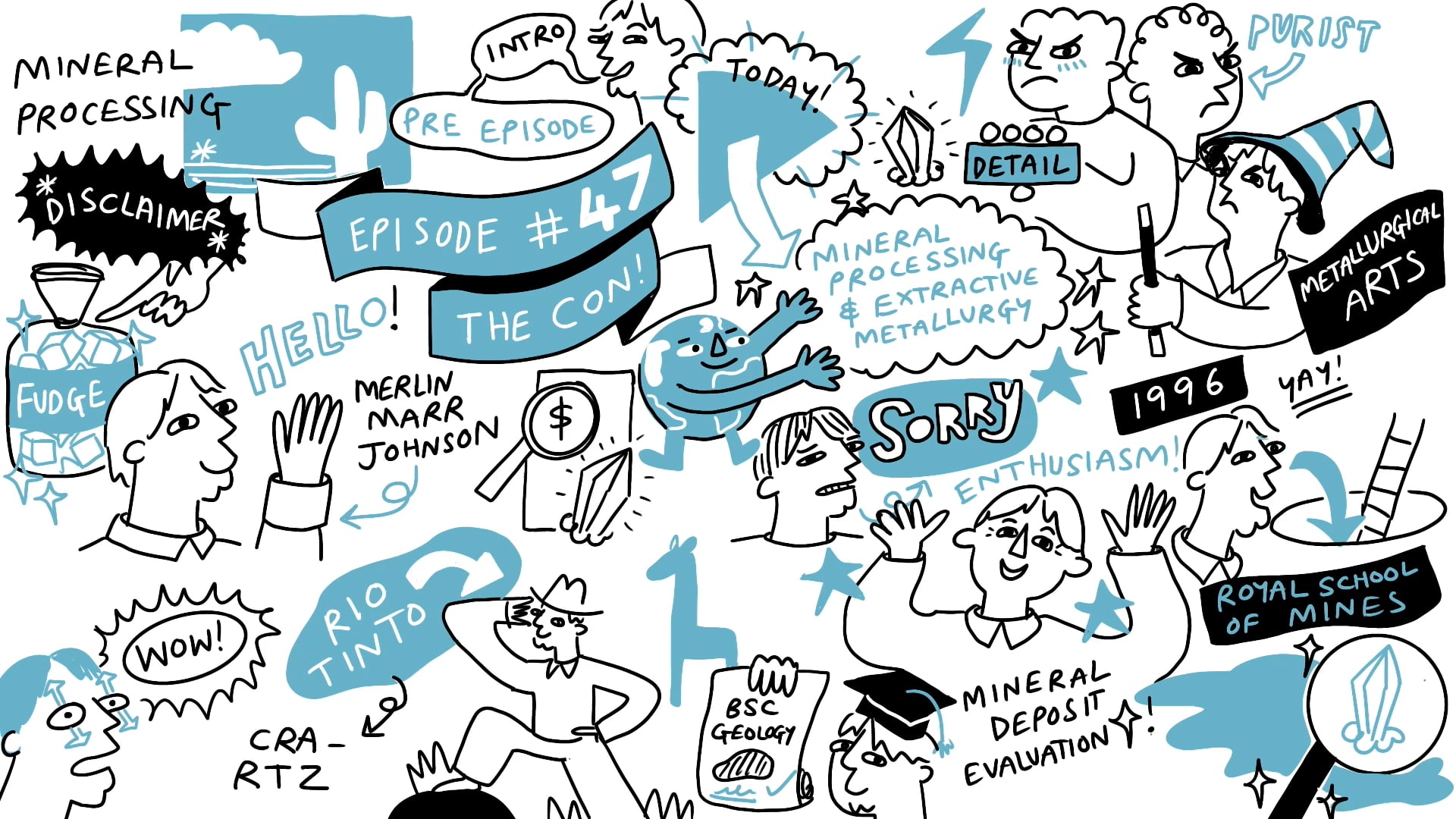Mineral processing: Crushing, grinding, separation & concentration
More episodes
Transcript
The most of this talk is about the separation, the liberation of value bearing minerals from waste to get the metals out of them. Comminution stage has got 2 stages, the crushing and the grinding. It actually starts with the mining. As soon as you start mining, you're starting to break it down into smaller bits. You use explosives, use excavators, you use scrapers for softer materials. And this is very much kind of a sequential process, you take the big material, you screen it, i.e., if it's too big to fit in the truck, you've got to break it up again. You would probably want to speak to your blasting engineers to make sure that the fragmentation of your rock is good. But it needs to be able to fit into the top of the machine, which is your primary crusher. These are often jaw crushers or gyratory crushes who use this equipment, and sometimes they are located in the mine themselves. There's been a lot of progress recently with X-ray sorting, X-ray diffraction techniques. So actually, now some mines, they do the primary crushing and they actually do a split underground and so that they can take out quite a lot of waste quite early on. And then you can either convey or truck already beneficiated material up to a kind of a secondary processing plant. But essentially, whether your primary crusher is underground or at the processing plant, you check your stuff into the top of the primary crusher, and it gets broken down to. There'll be some fines in there, but there shouldn't be anything over 10cm, it might be 5cm in diameter. You can get some slabbing or bits which are longer, but still slide through the process. But typically, they'll go through a screen even before your primary crusher, you'd have a grizzly out just to stop the really big bits going into grizzly as effectively a mesh or a set of bars, that stops the really big stuff going in, and that can be removed with a digger.
So typically, there are 2 stages of crushing, sometimes you might need a 3rd stage of crushing. Primary Crusher, as I said, is a big bit of equipment, a jaw or gyratory crusher. And these are effectively using compressive forces, you take the movement in a static place, and it's a course run of mine that comes in and it's much better sorted smaller material is typically as I said less than 5cm. That will then go into a secondary crusher, which are typically a cone crusher. The cone crusher is kind of just like a gyratory crusher but a bit smaller, often they've got a shorter spindle and a wider diameter. And then you can also go on to these roll crushers which are getting into the realms of grinding. And so each stage of crushing in combination takes you down, down to the grain size. So how fine are you going, and why are you trying to get there? Remember, what we're trying to do here is we're trying to liberate the value mineral from the non-value mineral. And the rule of thumb is that you have to grind down to half the diameter of your average value mineral grain size. Yeah, so if your value mineral is about 1mm across, you need to grind down to 0.5mm to liberate your value minerals at an economic level. That's a rule of thumb and each individual deposit will be slightly different. But that gives an indication that if you're dealing with a fine grained, very, very fine grain mineral, you've got to grind your ore down to dust pretty much. And that takes a lot of energy. Now obviously, if you've got a coarser grained value mineral, then you're going to save a lot of energy. And it's much easier to handle a sand than it is a dust. So the mineralogy and the petrography and the way that the mineral forms actually really does influence the cost of processing of your ore deposit.
When it comes to grinding, quite often you'll find that there's a primary mill and that these days, often a semi autogenous mill or an autogenous mill, which means that the weight of the material in this big drum that's rotating will actually break it down and break it down. And in the semi autogenous mill, it means that you chuck in about 5% to 10% by volume of the material that you've got in there in the form of steel balls and they help to break down this big drum. These mills are very large diameter relative to their length. So they can have a diameter which is 2x or 2.5x their length and as they rotate they got little baffles inside, sometimes not, they lift the material up the side because they're spinning at the right speed until it gets carried up beside and then when it gets close to the top, it falls down. It can't go too fast but otherwise it just gets stuck on through centrifugal forces to outside and they can't get too slow because otherwise it just rolls back. So you've got to get the speed just right so that the material essentially falls from the top to the bottom on every circuit and that takes material from about 5cm diameter down to 100 microns, 0.01mm. Sometimes you need to go into a secondary mil 100 microns might be fine enough, your value mineral might be liberated from your non-value mineral at 100 microns. Or you might need to go further down than that in which case again, a secondary mill which could be a rod mill, ball mill, pebble mill, these are kind of wet processes. It's all in the presence of water and essentially what you're trying to do is you're still focused on that liberation. Only once you've liberated, you've got everything jumbled up. And now you're into separation and concentration.
And so what you're trying to do is you're trying to take your liberated material and your classified particle size distribution, because what I haven't mentioned through all of this is you've got various screening and classification, so for example, you might do a kind of a slightly coarser cut in a Gold mine. For example, if you've got a coarse Gold fraction, and the gravity on it, the density of it is such that it can separate out very quickly under gravity, you'll have various streams coming up with different particle sizes. But this just look at the way that you separate can be done using a number of physical or chemical properties of the value minerals, and indeed, of the waste minerals. Some of the properties that you can use are, colour, texture, optical properties and radioactivity. And so that's kind of sorting and so this is where the X-ray sorting comes through. You can use the density of the material, the specific density of a metal will feed through to its physical properties. And so you can either use its behaviour in a cyclone at the specific gravity of the value mineral relative to the specific gravity of the waste material, and the way that it behaves in a cyclone in a spinning setting where the dense material will go to the edges, the light will gather in the centre. And you can also use dense media separation. For example, you can create a mixture of something like water and magnetite or ferrosilicon, to give you a very specific density, and if you've got a mineral which is denser than that, it will sink and if you've got a waste mineral which is lighter than that it will float and therefore you can separate it that way. So you can separate it, and then you can clean it and then you can reuse it. You can use magnetic properties of a mineral to separate it from its non-value members. Typically, an iron ore magnetite mine, that's a clue in the name works very well in magnetic separation. The thing about that is you've got to grind it fine. So, then you're suddenly into the whole complex processing of what to do with fine magnetite, do you slurry it? Do you turn it into pellet? How do you handle a magnetite fines, huge topic probably not for now.
And then what you see around the world, often in Copper and Gold mines and in Zinc and Lead is you get this thing called froth flotation which is separation based on the surface chemistry properties of a mineral. The surface property of the mineral which can be natural, or it can be modified in some kind of pre process that you've done. But the surface property of the mineral determined its ability to attach to an air bubble and float to the surface. And in some situations, you'll attach the waste product to the bubbles and the froth up to the top and then others it'll be the Sulphides themselves to value. So, there's a little bit more each of those I'll just mention the X-ray sorting methods because this is increasingly being used around the world. It was first demonstrated for use for Diamonds and Diamonds emit light when they are hit by an X-ray and the resulting light is then picked up by detector. What you do is you make sure that all of your little particles are coming through in a very, very fine mono lead it’s one particle fit lead comes a stream of rocks and Diamonds which fall through the X-ray beam. And the detector when it responds in a certain way it emits light. The detector activates jets of air which knock the particle, the value particle into a separate bin. So you can sort your Diamonds through X-ray sorting. This is being applied through kind of various variations on other mineral systems using laser. The laser reflects from the rotating mirror drum you can scan a falling stream of rocks 1000s of times a second. Photomultiplier detects the reflective light, reflected light and an air jet moves exactly right in an instant and so it's being used more and more in the mineral processing world. It's already proven on Barite and Talc and Tungsten but I think we will see more of that in the future.
It is worth mentioning the gravity side of things. The gravitational properties of minerals are really important. It's often used for Gold because the specific gravity of Gold is 19.6 times that of water and so it behaves very differently to water. You can use that property in cones and spirals and in sluices and this is a key feature of artisanal work, the panning, the washing, the screening that is done for Cassiterite, for Gold the world over and it's what the Romans used at Las Médulas in northern Spain. You can go there's this extraordinary site where they processed very, very low-grade gravels through a series of water powered sluices. So, in a sluice, what you've got is riffles in the sluice which retard and slow, heavy material from flowing in the slurry. It forms of material bed, traps heavy particles and creates turbulence and the turbulence causes the heavy particles to tumble and then they get kind of trapped on the baffles. Effectively, that is what the Romans used; they had sluices with baffles and they also use the fleeces of sheep to trap activated carbon, the organic matter of the fleeces also trap the Gold. You can have shaking tables, the shaking table is a bit of technology that has been around for hundreds of years, but it's still incredibly effective at trapping those heavier, denser minerals such as Cassiterite, the Tin or even for Diamonds and for Gold. Gravitational properties are absolutely key, the one that is probably applied, most commonly I've seen the most are these Knelson concentrators, the Falcon concentrator which companies that manufacture 2 of the most common centrifugal gravity concentrators. These are kind of a rifle cone or a bowl that spins at a relatively high speed to create forces in excess of 50, 60G. You then inject your slurry at an angle down the wall of the cone, and the centrifugal force produced by the rotation drives the solids towards the wall of the cone. That slurry then migrates up along the wall, where the heavier particles are captured by rifles is pretty cool. I mean, there's injected water, you can fluidize the rifle area and there prevents compaction, and it lasts for very efficient separation of heavy minerals, particularly Gold. And so you get a fine overflow and you get the course under flow. It's often used to capture the coarse element of your Gold stream when you're coming through. My goodness, we're getting there.
We've gone through all these different kinds of separation techniques, probably just worth a bit more on froth flotation. Because in terms of the daily tonnages of all that are treated globally, it's probably the single most important mineral recovery process. What makes it special is that you can tweak the reagents so that you can selectively separate different minerals. It's a physio-chemical process, you have these big tanks, which are either mechanically with baffles or pneumatically with bubbles or flow, you agitate the tanks, you generate air bubbles, which is the physical aspect of the process. And then the chemical aspect is provided by the reagents, which vary the surface properties of minerals, and the properties of the slurry medium. Typically, most common for Copper, Lead and Zinc but also for Sulphides and Gold as well. And you can use it for oxide minerals, you can use it for tin, because it's right you can use it for Malichite, Hematite and Fluoride and Phosphates and you can even use it for fine coal as well. flotation often involves modification of the surface properties to the desired minerals, and to do all kinds of clever chemistry kits and surfactants that which can change the mineral surface either make it hydrophobic, or hydrophilic. So your value mineral may preferentially adhere to the air bubbles and float to the surface. That's where the hydrophobic ones go into the air bubbles. And then the hydrophilic ones stay in the water and don't attach to the air bubbles. You can tinker the surface tension with other reagents, it's a pretty cool bit of chemistry kit. Then you scrape off the minerals, which are hydrophobic and are on the bubbles is skim the froth off the top, and you keep the hydrophilic minerals in the slurry. And that is your separation process.
We've done separation, what you've then got once you've separated it, you've effectively got a concentrate of minerals. In the case of a Gold plant, for example, you might have some coarse Gold coming off as kind of a Gold concentrated powder or dust with maybe some nuggets in there. But you're also very likely to have Gold in Sulphides, Gold locked up in pyrite, and iron sulphide, it might be Gold associated with other stuff, but it might be that the copper and whatever it is in Gold might be locked in. It might also be still bound in the oxides. Similarly, in a Copper mine, you may have separated your chunk of pyrite or your chalcocite or whatever the value mineral is, you might have separated it from the coarse and from the other non-value minerals, but it's still a Copper Sulphide or a Copper-oxide or Copper, whatever. And the same goes for most of them for the metals. What you then have to do is you have to extract the metal from the value mineral, you've created the concentrate. What happens at this point is you've got your concentrates and you've now got to work out what to do with them.










































.jpg)
.jpg)
.jpg)
.jpg)















